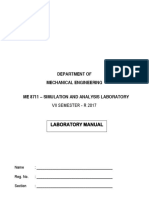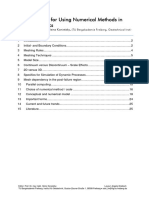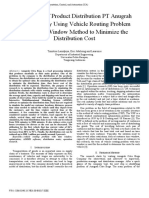NX Nastran Basic Fs W6
NX Nastran Basic Fs W6
Uploaded by
Praveen ThankachanCopyright:
Available Formats
NX Nastran Basic Fs W6
NX Nastran Basic Fs W6
Uploaded by
Praveen ThankachanOriginal Title
Copyright
Available Formats
Share this document
Did you find this document useful?
Is this content inappropriate?
Copyright:
Available Formats
NX Nastran Basic Fs W6
NX Nastran Basic Fs W6
Uploaded by
Praveen ThankachanCopyright:
Available Formats
NX
NX Nastran Basic
The core set of CAE capabilities that every new product development effort relies on
fact sheet
Siemens PLM Software
www.siemens.com/nx
NX Nastran Basic is the core subset of NX Nastran software and includes a robust suite of linear statics, normal modes, buckling analyses, heat transfer and basic nonlinear capabilities. NX Nastran Basic can play a key role in your virtual product development process by providing the most widely used CAE solutions for digital prototyping and simulation of product functional performance.
Benefits
Reduce risk by using simulation to save time and cost compared to physical test cycles Accelerate innovation through rapid iteration and numerous what-if studies Investigate product performance virtually under all possible operating conditions, including thermally-influenced operating conditions
NX Nastran Basic provides you access to a broad library of finite element types and material models, robust manipulation of load cases, along with several efficient solution sequences for linear statics, buckling and normal modes analyses on models of unlimited size. A heat transfer capability provides solutions to steady-state and transient thermal analysis and design problems. NX Nastran Basics nonlinear capability enables users to include large deformations and non-linear materials in their analyses.
Start simply, add as your needs evolve
NX Nastran Basic will allow you to initiate digital simulation into your product development process by providing access to a broad library of finite element types and material models, robust manipulation of load cases, along with several efficient solution sequences for linear statics (including buckling) and normal modes analyses on models of unlimited size. You can also perform sensitivity studies based on these analysis types. NX Nastrans powerful analysis capabilities will provide you with the tools you need for: Linear statics, including inertia relief Normal modes Buckling Design sensitivity (statics, modes, buckling) Model checkout Heat transfer Basic nonlinear Coupled structure/acoustic modes
fact sheet
NX
Features
Powerful analysis capabilities Complete element library including spot welds Full range of material models Easy combination and addition of load cases Comprehensive array of Eigensolvers Design sensitivity analysis for assessing design changes Efficient solvers Comprehensive thermal analysis capabilities Basic nonlinear capability for large displacement and material nonlinearities Surface-to-surface contact for linear static solutions Glue connections for joining dissimilar meshes
NX Nastran Basic includes a complete element library including 1D, 2D and 3D low- and higher-order elements; scalar and special elements including spot weld as well as p-elements (that can be combined with other elements).
Table 1 Element types supported by NX Nastran Basic
Element type Scalar Element name ELAS MASS BAR BEAM BEND ROD CONROD TUBE 2D QUAD4 QUAD8 QUADR SHEAR TRIA3 TRIA6 TRIA 3D HEXA PENTA TETRA PYRAMID RBAR RBE1 RBE2 RROD RTRPLT Interpolation RBE3 RSPLINE Description Scalar spring (several variations) Scalar mass (several variations) Simple beam element Complex beam element including shear center offset and variable cross section Curved beam, pipe or elbow Rod element tension-compression-torsion element
1D
Quadrilateral plate with membrane-bending or plane strain behavior Higher-order quadrilateral shell element Quadrilateral membrane or shell Shear panel Triangular plate with membrane-bending or plain strain behavior Higher-order triangular shell element Triangular membrane or shell Six-sided solid element with 8-20 grid points Five-sided solid element with 6-15 grid points Four-sided solid element with 4-10 grid points 5-sided solid element with 5-13 grid points Rigid bar element Rigid body connected to an arbitrary number of grid points Rigid body with independent DOFs at a grid point and dependent DOFs at an arbitrary number of grid points Pin-ended rigid rod Rigid triangular plate Defines motion of a reference point as the weighted average of the motions at a set of grid points Multipoint constraints for the interpolation of displacements at grid points Complex beam element Quadrilateral plate Higher-order quadrilateral plate Quadrilateral plate Triangular plate Higher-order triangular plate Triangular plate
Rigid
Composites
BEAM QUAD4 QUAD8 QUADR TRIA3 TRIA6 TRIAR
fact sheet
NX
Table 1 (continued)
Element type p-elements Element name HEXA PENTA TETRA CONEAX TRIAX6 CTRAX3 CTRAX6 CQUADX4 CQUADX8 CRAC2D CRAC3D CONM1 CONM2 DMI GENEL CWELD CFAST Description Six-sided solid element with 8-20 grid points Five-sided solid element with 6-15 grid points Four-sided solid element with 4-10 grid points Conical shell Triangular cross section ring Triangle Higher order triangle Quad Higher order quad Two-dimensional crack tip element Three-dimensional crack tip element 6-b-6 symmetric mass matrix Concentrated mass with offsets Direct matrix input General element Weld connection element Fastener element for shell patch connection
Axisymmetric
Crack tip
General
Weld Fastener
NX Nastran Basic provides a full range of material models: isotropic, orthotropic, anisotropic and temperature-dependent. It also allows for easy combination (or addition) of load cases, such as point, line and surface loads on elements; loads applied directly to geometry; thermal loads; enforced deformation; and weighted combinations of each type.
Table 2 Static loading types in NX Nastran Basic
Load type Point Load name FORCE MOMENT GMLOAD PLOAD1 GMLOAD PLOAD Description Concentrated force (several variations) Concentrated moment (several variations) Load distributed along a geometric curve Concentrated, uniform or linear load applied to 1D elements Load distributed along a geometric surface Pressure load applied to 2D elements or the face of 3D elements (several variations) Steady-state acceleration vectors Angular velocity or acceleration Spatial varying acceleration load Bolt preload applied to beam elements Enforced displacements for geometry (curves and surfaces) Constraints applied to geometry Constraints applied to grid points (several variations)
Curve
Surface
Volume
GRAV RFORCE ACCEL BOLTFOR GMBC GMSPC SPC
Bolt preload Enforced motion
fact sheet
NX
Table 2 (continued)
Load type Thermal Load name TEMP TEMPP1 TEMPRB FORCEAX MOMAX PLOAD1X PRESAX SPCAX TEMPAX DMI LOAD Description Temperatures applied to grid points (several variations) 2D element temperature field 1D element temperature field Concentrated force Concentrated moment Surface traction Pressure loading Constraints Applied temperatures Direct matrix input Combine load sets Non-structural mass sets
Axisymmetric
General Combination
Non-structural mass NSM
NX Nastran Basic provides several non-elemental approaches for connecting meshes and transferring loads. This can greatly simplify modeling procedures.
Table 3 Non-elemental mesh connections in NX Nastran Basic
Type Constraint Name MPC RSSCON Contact BSURF BSURFS BCTSET BSURF BSURFS BGSET Description Constraint equations used to connect specified degreesof-freedom Constraint relation to connect shell to solid elements A set of shell element faces that define a contact surface A set of solid element faces that define a contact surface Pairs of contact surfaces that can contact in a linear static solution A set of shell element faces that define a glue surface A set of solid element faces that define a glue surface Pairs of glue surfaces that are in connection in any solution type
Glue
Additional capabilities for linear static and Eigenvalue solutions:
Linear static solutions: Surface-to-surface contact for shell and solid elements Inertia relief for unrestrained models Element-based iterative solver for very fast solutions of tetrahedron meshed models Bolt preload effects Thermal expansion for rigid elements
fact sheet
NX
Normal mode solutions Lanczos Residual vectors for residual flexibility Differential stiffness effects Unconstrained model solutions Solution about a contact condition Export modes to ADAMS or RecurDyn Design sensitivity analysis for assessing design changes: Shape and sizing design variables Preset objective and constraints Weight, volume Element stress, strain, force Displacement, rotation, reaction force Normal modes Eigenvalue Buckling load factor Composites: lamina strain, force and failure index User-defined objective and constraints Efficient handling of hundreds of design variables, constraints and load cases buckling in a single run Efficient solvers: Sparse matrix solvers for faster speed and minimal disk space usage Automatic internal resequencing for bandwidth reduction Restarts to take advantage of previously computed solutions
Steady-state and transient thermal analysis
NX Nastran Basic provides heat transfer solutions to steady-state and transient thermal analysis design problems. This capability may also be used in combination with NX Nastran structural analyses to perform thermal stress analysis. If changes in temperature and the flow of heat within your product could affect its performance, heat transfer should play a key role in your digital simulation process. Heat transfer can span the full range from system-level analysis of global energy balances to the detailed analysis associated with temperature and thermal stress limit levels. It allows you to investigate linear or nonlinear problems, steady-state or transient effects, as well as all three types of heat transfer (conduction, convection and radiation), displaying the characteristics associated with each. Heat conduction: Temperature-dependent conductivity Temperature-dependent specific heat Anisotropic thermal conductivity Latent heat of phase change Temperature-dependent internal heat generation Weighted temperature gradient-dependent internal heat generation Time-dependent internal heat generation
fact sheet
NX
Free convection boundaries: Temperature-dependent heat transfer coefficient Weighted temperature gradient-dependent heat transfer coefficient Time-dependent heat transfer coefficient Nonlinear functional forms Weighted film temperatures Forced convection: Tube fluid flow field relationships Temperature-dependent fluid viscosity, conductivity and specific heat Time-dependent mass flow rate Temperature-dependent mass flow rate Weighted temperature gradient-dependent mass flow rate Radiation to space: Temperature-dependent and wavelength-dependent emissivity Diffuse 3D view factor calculations with self and third-body shadowing Adaptive view factor calculations Net view factors User-supplied exchange factors Radiation matrix control Multiple radiation enclosures Applied heat loads: Direction and surface normal heat flux Grid point nodal power Temperature-dependent and weighted gradient-dependent heat flux Time-dependent heat flux Temperature boundary conditions Temperature initial conditions
Basic nonlinear analysis
NX Nastran Basic enables you to analyze models with geometric nonlinearities; that is, large deformations or with material nonlinearities. Point-to-point contact nonlinearity can also be simulated. This basic nonlinear capability allows users to evaluate whether the small displacement and linear material assumptions used in linear analysis are accurate. Geometric nonlinear behavior: Large deformations Large strain for hyperelastic material Snap-through analysis (post-buckling)
fact sheet
NX
Material nonlinear behavior Plasticity Hyperelasticity Thermoelasticity Viscoelasticity (creep) Automated solution methods statics: Load control method Displacement control method Adaptive load increment Other features Static and transient solutions Restart analysis Identical element types in linear and nonlinear analysis Point-to-point contact with gap elements
Contact
Siemens PLM Software www.siemens.com/nx Americas 800 498 5351 Europe 44 (0) 1276 702000 Asia-Pacific 852 2230 3333
2010 Siemens Product Lifecycle Management Software Inc. All rights reserved. Siemens and the Siemens logo are registered trademarks of Siemens AG. D-Cubed, Femap, Geolus, GO PLM, I-deas, Insight, Jack, JT, NX, Parasolid, Solid Edge, Teamcenter, Tecnomatix and Velocity Series are trademarks or registered trademarks of Siemens Product Lifecycle Management Software Inc. or its subsidiaries in the United States and in other countries. All other logos, trademarks, registered trademarks or service marks used herein are the property of their respective holders. W6 2661 3/10 B
You might also like
- Exercise 1: Geostatistics: + ) H) K (X K (X) (2N 1 (H)0% (1)Exercise 1: Geostatistics: + ) H) K (X K (X) (2N 1 (H)8 pages
- Frank H. Knight-Intelligence and Democratic Action-Harvard University Press (1960)No ratings yetFrank H. Knight-Intelligence and Democratic Action-Harvard University Press (1960)184 pages
- GuidelineOnStructuralFireEngineering (Part2)No ratings yetGuidelineOnStructuralFireEngineering (Part2)62 pages
- NX Nastran Advanced Nonlinear - Solution 601-701No ratings yetNX Nastran Advanced Nonlinear - Solution 601-7013 pages
- NX Nastran Advanced Nonlinear - Solution 601/701: BenefitsNo ratings yetNX Nastran Advanced Nonlinear - Solution 601/701: Benefits3 pages
- Structural Analysis Introductory TutorialNo ratings yetStructural Analysis Introductory Tutorial48 pages
- SimXpert R3.2 Structures Workspace GuideNo ratings yetSimXpert R3.2 Structures Workspace Guide518 pages
- Ansysworkbench: Prof. N. S. Surner Sres Sanjivani College of Engineering, KopargaonNo ratings yetAnsysworkbench: Prof. N. S. Surner Sres Sanjivani College of Engineering, Kopargaon24 pages
- NX Nastran Advanced Nonlinear - Solution 601/701: Siemens PLM SoftwareNo ratings yetNX Nastran Advanced Nonlinear - Solution 601/701: Siemens PLM Software3 pages
- Ructural Nalysis ND Esign Gram: ST A A D ProNo ratings yetRuctural Nalysis ND Esign Gram: ST A A D Pro31 pages
- Ructural Nalysis ND Esign Gram: ST A A D ProNo ratings yetRuctural Nalysis ND Esign Gram: ST A A D Pro31 pages
- ANSYS Workbench: Prof. N. S. Surner SRES Sanjivani College of Engineering, KopargaonNo ratings yetANSYS Workbench: Prof. N. S. Surner SRES Sanjivani College of Engineering, Kopargaon24 pages
- Department of Mechanical Engineering: Laboratory ManualNo ratings yetDepartment of Mechanical Engineering: Laboratory Manual52 pages
- Department of Mechanical Engineering: Laboratory ManualNo ratings yetDepartment of Mechanical Engineering: Laboratory Manual52 pages
- Department of Mechanical Engineering: Laboratory ManualNo ratings yetDepartment of Mechanical Engineering: Laboratory Manual52 pages
- Me 6711 - Simulation & Analysis LaboratoryNo ratings yetMe 6711 - Simulation & Analysis Laboratory71 pages
- Nonlinear Analysis Using Femap With NX NastranNo ratings yetNonlinear Analysis Using Femap With NX Nastran31 pages
- 09 Practical Hints Using Numerical Methods Rock MechanicsNo ratings yet09 Practical Hints Using Numerical Methods Rock Mechanics26 pages
- Prokon Brochure Structural Analysis 2017-08-29No ratings yetProkon Brochure Structural Analysis 2017-08-298 pages
- Introduction To Finite Element Method (FEM)100% (1)Introduction To Finite Element Method (FEM)22 pages
- Multiphysics Solution: The Most Comprehensive Coupled Physics SolutionNo ratings yetMultiphysics Solution: The Most Comprehensive Coupled Physics Solution4 pages
- Adaptive Refinement in Vibrational Analysis and Isogemetric AnalysisNo ratings yetAdaptive Refinement in Vibrational Analysis and Isogemetric Analysis22 pages
- Ntroduction: Speed of Cheetah Speed of Man 120 KM Per Hour 20 KM Per HourNo ratings yetNtroduction: Speed of Cheetah Speed of Man 120 KM Per Hour 20 KM Per Hour20 pages
- Foundations of Quantum Field Theory and FractalsNo ratings yetFoundations of Quantum Field Theory and Fractals85 pages
- Simulation of Product Distribution PT Anugrah Citra Boga by Using Vehicle Routing Problem With Time Window Method To Minimize The Distribution CostNo ratings yetSimulation of Product Distribution PT Anugrah Citra Boga by Using Vehicle Routing Problem With Time Window Method To Minimize The Distribution Cost4 pages
- Gen Phy1 Module1 - Units Physical Quantities Measurement - Version3No ratings yetGen Phy1 Module1 - Units Physical Quantities Measurement - Version332 pages
- Abhiram Sathiraju - AssessmentCenterReport - 163No ratings yetAbhiram Sathiraju - AssessmentCenterReport - 16329 pages
- Secure Data Deduplication and Auditing For Cloud Data Storage 1 1No ratings yetSecure Data Deduplication and Auditing For Cloud Data Storage 1 14 pages
- (Adaptive Computation and Machine Learning) Brendan J. Frey - Graphical Models For Machine Learning and Digital Communication-The MIT Press (1998)No ratings yet(Adaptive Computation and Machine Learning) Brendan J. Frey - Graphical Models For Machine Learning and Digital Communication-The MIT Press (1998)203 pages
- Engineering Analysis With NX Advanced SimulationFrom EverandEngineering Analysis With NX Advanced Simulation
- Exercise 1: Geostatistics: + ) H) K (X K (X) (2N 1 (H)Exercise 1: Geostatistics: + ) H) K (X K (X) (2N 1 (H)
- Frank H. Knight-Intelligence and Democratic Action-Harvard University Press (1960)Frank H. Knight-Intelligence and Democratic Action-Harvard University Press (1960)
- NX Nastran Advanced Nonlinear - Solution 601/701: BenefitsNX Nastran Advanced Nonlinear - Solution 601/701: Benefits
- Ansysworkbench: Prof. N. S. Surner Sres Sanjivani College of Engineering, KopargaonAnsysworkbench: Prof. N. S. Surner Sres Sanjivani College of Engineering, Kopargaon
- NX Nastran Advanced Nonlinear - Solution 601/701: Siemens PLM SoftwareNX Nastran Advanced Nonlinear - Solution 601/701: Siemens PLM Software
- ANSYS Workbench: Prof. N. S. Surner SRES Sanjivani College of Engineering, KopargaonANSYS Workbench: Prof. N. S. Surner SRES Sanjivani College of Engineering, Kopargaon
- Department of Mechanical Engineering: Laboratory ManualDepartment of Mechanical Engineering: Laboratory Manual
- Department of Mechanical Engineering: Laboratory ManualDepartment of Mechanical Engineering: Laboratory Manual
- Department of Mechanical Engineering: Laboratory ManualDepartment of Mechanical Engineering: Laboratory Manual
- 09 Practical Hints Using Numerical Methods Rock Mechanics09 Practical Hints Using Numerical Methods Rock Mechanics
- Multiphysics Solution: The Most Comprehensive Coupled Physics SolutionMultiphysics Solution: The Most Comprehensive Coupled Physics Solution
- Adaptive Refinement in Vibrational Analysis and Isogemetric AnalysisAdaptive Refinement in Vibrational Analysis and Isogemetric Analysis
- Ntroduction: Speed of Cheetah Speed of Man 120 KM Per Hour 20 KM Per HourNtroduction: Speed of Cheetah Speed of Man 120 KM Per Hour 20 KM Per Hour
- Simulation of Product Distribution PT Anugrah Citra Boga by Using Vehicle Routing Problem With Time Window Method To Minimize The Distribution CostSimulation of Product Distribution PT Anugrah Citra Boga by Using Vehicle Routing Problem With Time Window Method To Minimize The Distribution Cost
- Gen Phy1 Module1 - Units Physical Quantities Measurement - Version3Gen Phy1 Module1 - Units Physical Quantities Measurement - Version3
- Secure Data Deduplication and Auditing For Cloud Data Storage 1 1Secure Data Deduplication and Auditing For Cloud Data Storage 1 1
- (Adaptive Computation and Machine Learning) Brendan J. Frey - Graphical Models For Machine Learning and Digital Communication-The MIT Press (1998)(Adaptive Computation and Machine Learning) Brendan J. Frey - Graphical Models For Machine Learning and Digital Communication-The MIT Press (1998)
























































































